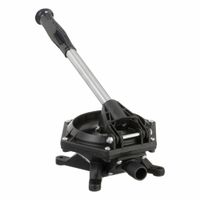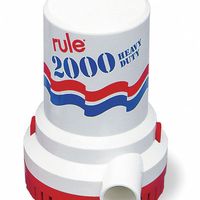Call +(254) 703 030 000 / 751 483 999 / 721 704 777
- Home
- Pumps
- Marine Pumps
- Marine Bilge Pumps
.....Read More
Frequently Asked Questions
What is a bilge pump and how does it work?
A bilge pump is a device used to remove water that accumulates in the bilge of a boat. The bilge is the lowest part of a boat's hull, where water can collect due to rain, leaks, or waves. Bilge pumps are essential for maintaining buoyancy and preventing water from reaching levels that could compromise the vessel's stability or safety.
There are two main types of bilge pumps: manual and electric. Manual bilge pumps require human effort to operate, typically using a hand or foot pump mechanism. They are simple, reliable, and do not rely on power sources, making them useful as backup systems.
Electric bilge pumps are more common and convenient, especially for larger vessels. They are powered by the boat's battery and can be either centrifugal or diaphragm pumps. Centrifugal pumps use a rotating impeller to create a low-pressure area that draws water in and expels it through an outlet hose. They are efficient for moving large volumes of water but may not handle debris well. Diaphragm pumps use a reciprocating diaphragm to create suction, which can handle debris better but may have lower flow rates.
Bilge pumps are often equipped with automatic float switches that activate the pump when water reaches a certain level. This automation ensures that water is removed without requiring constant monitoring. Some systems also include alarms to alert the crew if the water level becomes dangerously high.
Proper installation and maintenance of bilge pumps are crucial. This includes ensuring the pump is securely mounted, the discharge hose is free of obstructions, and the pump is regularly tested for functionality. Regular checks help ensure the bilge pump operates effectively, providing peace of mind and safety for those on board.
How do I choose the right bilge pump for my boat?
To choose the right bilge pump for your boat, consider the following factors:
1. **Boat Size and Type**: Larger boats require more powerful pumps. Consider the boat's design and the areas where water might accumulate.
2. **Pump Capacity**: Measured in gallons per hour (GPH), the pump's capacity should match the boat's needs. A general rule is to have a pump that can handle at least 1,000 GPH for small boats, with larger boats requiring higher capacities.
3. **Power Source**: Ensure the pump is compatible with your boat's electrical system, typically 12V for most recreational boats. Check the amperage to ensure it matches your battery capacity.
4. **Automatic vs. Manual**: Automatic pumps have a float switch that activates the pump when water reaches a certain level, providing convenience and safety. Manual pumps require you to turn them on, offering more control.
5. **Discharge Hose Size**: The hose size affects the pump's efficiency. Ensure the hose diameter matches the pump's outlet and is long enough to discharge water overboard effectively.
6. **Installation Location**: Choose a pump that fits the available space in your bilge area. Consider ease of access for maintenance and cleaning.
7. **Material and Durability**: Pumps should be made of corrosion-resistant materials like stainless steel or high-quality plastic, especially for saltwater environments.
8. **Brand and Warranty**: Opt for reputable brands known for reliability and customer support. A good warranty can provide peace of mind.
9. **Budget**: Balance cost with quality and features. Investing in a reliable pump can prevent costly damage from water ingress.
10. **Regulations and Safety Standards**: Ensure the pump meets marine safety standards and regulations for your region.
By evaluating these factors, you can select a bilge pump that ensures safety and efficiency for your boating needs.
What are the differences between manual and electric bilge pumps?
Manual bilge pumps and electric bilge pumps differ primarily in their operation, power source, and application.
Manual bilge pumps are operated by hand, requiring physical effort to pump water out of the bilge. They are simple, reliable, and do not rely on electricity, making them useful in emergency situations or on small boats where power supply is limited. Manual pumps are typically lightweight, portable, and easy to maintain, but they can be labor-intensive and less efficient for removing large volumes of water.
Electric bilge pumps, on the other hand, are powered by the boat's electrical system, allowing for automatic operation. They are equipped with a float switch or sensor that activates the pump when water reaches a certain level, providing convenience and efficiency. Electric pumps can handle larger volumes of water quickly, making them suitable for larger vessels or situations where rapid water removal is necessary. However, they depend on a reliable power source and can be more complex to install and maintain.
In summary, manual bilge pumps offer simplicity and independence from power sources, while electric bilge pumps provide automation and efficiency. The choice between the two depends on the size of the vessel, the availability of power, and the specific needs of the boater.
How do I install a bilge pump in my boat?
1. **Select the Pump**: Choose a bilge pump suitable for your boat's size and type. Consider the pump's capacity, power source, and whether it’s manual or automatic.
2. **Gather Tools and Materials**: You’ll need a drill, screwdriver, wire cutters, marine-grade wire, hose clamps, a bilge hose, a through-hull fitting, and sealant.
3. **Choose a Location**: Install the pump at the lowest point in the bilge where water collects. Ensure it’s accessible for maintenance.
4. **Mount the Pump**: Secure the pump using screws or a mounting bracket. Ensure it’s stable and won’t shift during operation.
5. **Install the Discharge Hose**: Attach the bilge hose to the pump’s outlet. Run the hose to a through-hull fitting above the waterline. Avoid sharp bends and ensure the hose is secure with clamps.
6. **Install the Through-Hull Fitting**: Drill a hole above the waterline for the fitting. Apply sealant around the fitting and secure it in place.
7. **Wire the Pump**: Connect the pump to the power source using marine-grade wire. If it’s an automatic pump, connect the float switch. Use waterproof connectors and secure the wiring to prevent chafing.
8. **Test the Pump**: Pour water into the bilge to ensure the pump activates and discharges water properly. Check for leaks in the hose and fitting.
9. **Secure and Clean Up**: Ensure all components are secure. Clean up any debris or tools from the installation area.
10. **Regular Maintenance**: Periodically check the pump, hoses, and wiring for wear or damage. Test the pump regularly to ensure it’s operational.
How often should I test or maintain my bilge pump?
You should test and maintain your bilge pump at least once a month. Regular testing ensures that the pump is operational and can handle unexpected water ingress. Here’s a detailed maintenance routine:
1. **Monthly Testing**: Activate the pump manually to ensure it starts and runs smoothly. Check the automatic float switch by lifting it to verify the pump activates automatically.
2. **Inspect for Debris**: Examine the pump and the bilge area for debris that could clog the pump or impede its operation. Clean the strainer and remove any obstructions.
3. **Check Electrical Connections**: Ensure all wiring and connections are secure and free from corrosion. Corroded connections can lead to pump failure.
4. **Battery Check**: If your pump is battery-operated, inspect the battery for charge and corrosion. A weak battery can prevent the pump from functioning during an emergency.
5. **Hose Inspection**: Examine the discharge hose for kinks, cracks, or blockages. Ensure it is securely attached and free from leaks.
6. **Annual Maintenance**: At least once a year, perform a more thorough inspection. Remove the pump from the bilge, clean it thoroughly, and check for wear and tear. Replace any worn parts.
7. **Test After Heavy Use**: After heavy rain or rough seas, test the pump to ensure it hasn’t been damaged or clogged by debris.
8. **Record Keeping**: Maintain a log of all tests and maintenance activities. This helps track the pump’s reliability and anticipate potential issues.
Regular maintenance and testing of your bilge pump are crucial for safety and can prevent costly repairs or dangerous situations on the water.
What are the signs of a failing bilge pump?
Signs of a failing bilge pump include:
1. **Unusual Noises**: Grinding, whining, or other abnormal sounds may indicate mechanical issues or debris obstructing the pump.
2. **Inconsistent Operation**: The pump may start and stop erratically, suggesting electrical problems or a failing motor.
3. **Reduced Water Flow**: A decrease in the amount of water being expelled can signal blockages, worn impellers, or a weakening motor.
4. **Failure to Activate**: If the pump doesn't turn on when water levels rise, it could be due to a faulty float switch, electrical connection issues, or a dead pump.
5. **Overheating**: Excessive heat from the pump can indicate it's working harder than normal, possibly due to blockages or mechanical failure.
6. **Frequent Blown Fuses**: Repeatedly blown fuses may point to electrical faults or an overworked pump drawing too much current.
7. **Visible Damage**: Cracks, corrosion, or other physical damage to the pump or its components can impair functionality.
8. **Persistent Water in Bilge**: If water remains in the bilge despite the pump running, it may not be effectively removing water due to clogs or mechanical failure.
9. **Battery Drain**: A failing pump may draw excessive power, leading to rapid battery depletion.
10. **Manual Override Required**: Needing to manually activate the pump frequently can indicate automatic system failures.
11. **Water Leaks**: Leaks around the pump or its connections can reduce efficiency and indicate wear or damage.
12. **Age and Wear**: Older pumps are more prone to failure due to wear and tear over time.
Regular maintenance and inspections can help identify these signs early and prevent complete pump failure.
Can a bilge pump run dry without damage?
Yes, a bilge pump can generally run dry without damage, but it depends on the type and design of the pump. Most modern electric bilge pumps are designed to handle running dry for short periods without incurring damage. These pumps typically use centrifugal mechanisms, which do not rely on the pumped fluid for lubrication or cooling, allowing them to operate without water for a limited time.
However, prolonged dry running can lead to overheating and potential damage. The motor may overheat if it runs dry for too long, as water usually helps dissipate heat generated during operation. Additionally, some pumps have built-in thermal protection that automatically shuts off the pump if it overheats, preventing damage.
In contrast, diaphragm bilge pumps, which use a different mechanism, are more tolerant of dry running. They can often run dry without any risk of damage because they do not rely on the pumped fluid for lubrication or cooling.
To ensure the longevity of a bilge pump, it is advisable to avoid running it dry for extended periods. Regular maintenance, such as checking for blockages and ensuring the pump is primed with water, can help prevent dry running. Additionally, installing an automatic float switch can help ensure the pump only operates when necessary, reducing the risk of dry running.
In summary, while most bilge pumps can handle short periods of dry running without damage, it is best to minimize such occurrences to prolong the pump's lifespan and maintain optimal performance.

